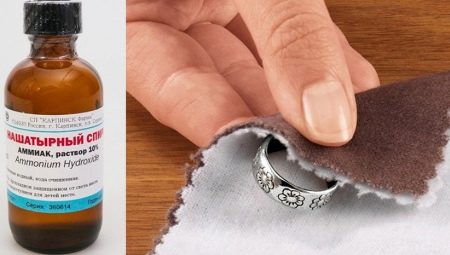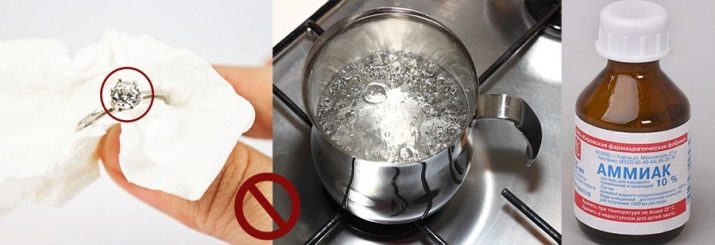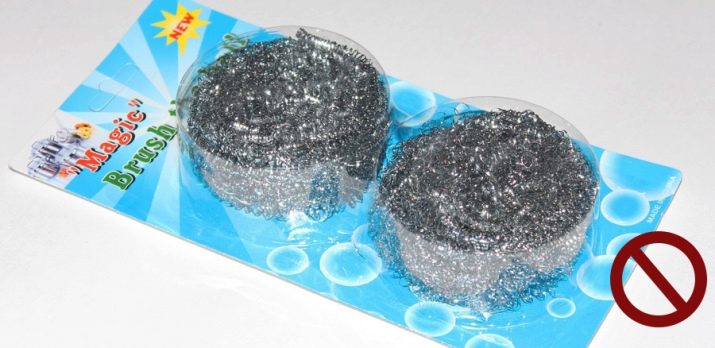Cleaning silver with ammonia

Silver items lose their attractiveness, begin to darken due to contact with the environment. The problem is associated with a change in the chemical properties of the individual constituents of the alloy. Cleaning requires the use of aggressive agents. Darkening can be fought with the help of ammonia.

Can I clean with ammonia?
Ammonia is a strong oxidizing agent. It can be used to remove blackening and plaque. Cleaning silver with ammonia is a common and safe method. Ammonia is readily available and is easy to find at any pharmacy.
An important advantage of ammonia is that it dissolves in water, so it does not harm the metal.
It is worth noting that it also has some drawbacks. For example, you cannot use a cleaner for gilded silver and pearl items.
The same can be said about tableware. If you wash off the product badly, then it can get inside the body. Ammonia, even in small quantities, provokes burns of the mucous membranes. Silver is a ductile material. Alloys with the addition of copper are used for the manufacture of jewelry. Any sample can be cleaned with ammonia. The tool will remove blackening and any plaque.

How to clean it properly?
Cleaning of silver items with ammonia is available to everyone at home... So, cleaning solutions will get rid of blackness and other oxidations. The easiest way is to mix ammonia, liquid soap, and peroxide. All components are taken in equal amounts and added to the water. By the way, it's better to take baby soap.
Quite an effective remedy turns out when mixing ammonia and tooth powder. Such a composition is suitable only if the decoration is without a stone. Mix 5 tbsp. l. warm water, 1 tbsp. l. tooth powder and 2 tbsp. l. ammonia.
There is the easiest way to clean silver jewelry. You just need add 2 tbsp. l. ammonia in a 2 liter container with water and put silver in the solution for 10-15 minutes.
After processing, rub the products. Rinsing with clean water is optional.

An effective way of cleaning is boiling with a suitable solution.
- Collect 0.5 liters of water in a stainless steel saucepan. Add 50-100 ml of dishwashing liquid. The thicker the detergent, the less it is needed.
- Submerge the silver to be cleaned completely in water.
- Bring to a boil, boil for 5 minutes. Turn off the gas.
- Pour 20 ammonia cubes into a saucepan with a syringe. Quickly close the container with a lid, turn on the hood and leave for 10-15 minutes. Do not keep it longer.
- Then it all depends on the features of the jewelry. Simple shapes are easily cleaned of blackness. If necessary, you can take an old toothbrush and brush your jewelry. This will get you to all the notches.

Standard recipes work well with rings and pendants without inserts. Radiated items, blackened silver and jewelry with stones require special attention. The chains should be carefully cleaned, because they are susceptible to many contaminants.
The more complex the weaving, the more the product will darken. Remains of cosmetics and shower products accumulate in inaccessible places. After boiling, place the chain in a liquid soap bottle. Add 100 ml of hot water, 50 ml of detergent to the container. Now you need to tightly close the lid and shake the bottle vigorously for 5-10 minutes. The chain should be removed and rinsed under the tap. With regular cleaning in this way, the product will always sparkle.
It is worth noting that it makes no sense to clean a chain with a complex weaving with a toothbrush. The bristles simply won't be able to pull out the dirt.

Jewelry with stones requires regular maintenance.... Usually, there are no natural inserts in silver jewelry, and there are no prohibitions when cleaning synthetics. After boiling in the same solution, you should clean the product with a toothbrush. In this case, you need to act as carefully as possible, it is better to take a tool with a soft bristle. Silver is a soft metal, so there is a risk of unbending the stone mounts.
There are still natural stones in the product, for example: pearls, coral, amber, etc., it is forbidden to boil with ammonia. The appearance can be damaged irrevocably.
Some natural stones are attached with a special glue that can dissolve at high temperatures. Use only soapy water and a toothbrush for cleaning.
Blackened silver has a decorative coating. So, the whole product is darkened, and the protruding parts are highlighted. The result is an unusual surface with contrast. It is strictly forbidden to use ammonia, acetic acid and other aggressive agents for cleaning.

It should be noted that decoration with blackening suffer less from environmental influences and darken much longer. You can boil the products, but without ammonia. A soapy solution will do the job perfectly. Otherwise, the color will turn gray, and the decorative coating itself will be destroyed.
Radiated silver no less interesting. The product is coated with a coating that protects it from oxidation. All cleaning consists only in removing household dirt. Liquid ammonia will not harm a quality coating. If you need to deal with serious pollution, then it is quite possible to use it.
Do not use abrasive substances. They can scratch the surface and ruin the attractive gloss.
Only a professional will be able to restore the product.... The jeweler will have to polish the piece again.

Precautionary measures
Ammonia is a corrosive substance. If mishandled, it may well harm the body. There are several rules to follow when cleaning.
- Use gloves. Especially if you get the products out of the ammonia solution with your hands, and not with tools. The ammonia can corrode the skin, leaving a chemical burn.
- If ammonia got on the skinthen it is worth rinsing it with plenty of water. Much worse if mucous membranes are affected. They also need to be rinsed with plenty of water and a doctor should be consulted as soon as possible.
- It is recommended to lower and remove the silver from the solution. with tweezers or other tool.
- Do not bend over a container with ammonia and breathe its vapors... They are quite toxic and can cause poisoning. In some cases, damage to the lining of the airways is possible. It is also recommended to use a mask.
- Clean products only in a well-ventilated area. You can also use the hood in the kitchen, for example.


Simple rules will keep you healthy after using ammonia. Also, when boiling, it is worth removing children and pets from the room. It is when heated, the vapors become especially aggressive. After using the ammonia solution, it is worth rinsing the decorations thoroughly. Otherwise, the residues of the substance may affect the skin during use of the product.
How to properly clean silver with ammonia, see the next video.








